


It is too bad that the Kamo-michi かも道 route is so underrated among walking pilgrims despite its historical value, beautiful and various scenery, and several sites with interesting stories along the 4.5 km trail.

The oldest Shikoku Pilgrimage trail on record
The Kamo-michi is called “the oldest pilgrimage trail in Shikoku” as there are several old stone distance posts along the trail, and one of them has the year it was set there inscribed; A.C.1365.

The stone-paved trail to T20 Kakurinji also has old stone distance pillars like the Kamo-Michi ones, but the oldest of them was one year younger than the A.C. 1365 one. No older pilgrimage sign has been found in Shikoku yet.
I am sure some other Shikoku Pilgrimage trails are as old as or possibly older than Kamo-michi, but they don’t have any old signs or pilgrim gravestones that can prove people walked there more than 650 years ago.

The main factor that makes most pilgrim walkers hesitate to take the route must be the extra 3km walk from the Suii bridge to get to its trailhead, especially when most pilgrims are already in a rush to walk through three mountains in one day to visit T20 and T21 and still make it to the T22 area before dark.
You may wonder why the trailhead of Kamomichi is located so far away from the Suii bridge, and the route approaches T21 Tairyuji 太龍寺 from a far different direction.
Well, a long, long time ago, pilgrims didn’t walk down to the Suii Bridge valley after they visited T20. Until some decades ago, there was no bridge crossing the river. When the elders in their mid-70s or older in the valley along the Nakagawa River were kids, they crossed the river by small boats to school.
Several hundreds of years ago, after T20, pilgrims would walk to the east on a path running through the upper parts of the mountains and finally make a descent to the valley to cross the river near the Kamo-michi trailhead.

One of the early Shikoku Pilgrimage guidebooks published 335 years ago, in 1687, describes the route between T20 and T21 back then; the trail going straight down to where the Suii bridge is now and going up to today’s Tairyuji route was a shortcut.
Although almost all temples in Shikoku seem to have a story related to Kobo-Daishi and thousands of mysterious legends of him are left all over Shikoku, he mentioned only two sites in his book that he visited; the sacred cave near T24 and T21. When Kobo-Daishi walked up to T21, he was most likely to take the Kamo-michi route.
(On a side note, he didn’t specifically refer to T21 but wrote “the Tairyu mountain in Tokushima,” which gives space for another temple, B20 Ōtakiji 大瀧寺 precisely, to claim that they are indeed the true one…)
However, for approximately 300 years after the oldest distance post was built, pilgrims apparently sought a quicker way to get to T21 and they managed to draw a new trail line by their footsteps.
Now it makes sense why the trailhead of Kamo-Michi is where it is now. But just like old pilgrims didn’t want to go down all the way to another side of the mountain, today’s busy walking pilgrims don’t have time for it either.
So the Kamo-michi trail remains a genuinely off-the-beaten path among the Shikoku Pilgrims routes, and instead, it has gained new popularity among local regular day-hikers and trail runners for their training.

I could write dozens of pages only about Kamo-michi. I got a lot of hands-on knowledge and old stories about it from my older friends whose families have lived in the area for generations (the oldest one can trace back their family lines through 14 generations.)
But for now, let’s move on and talk about the latter half of our Shikoku Pilgrimage Day 20.
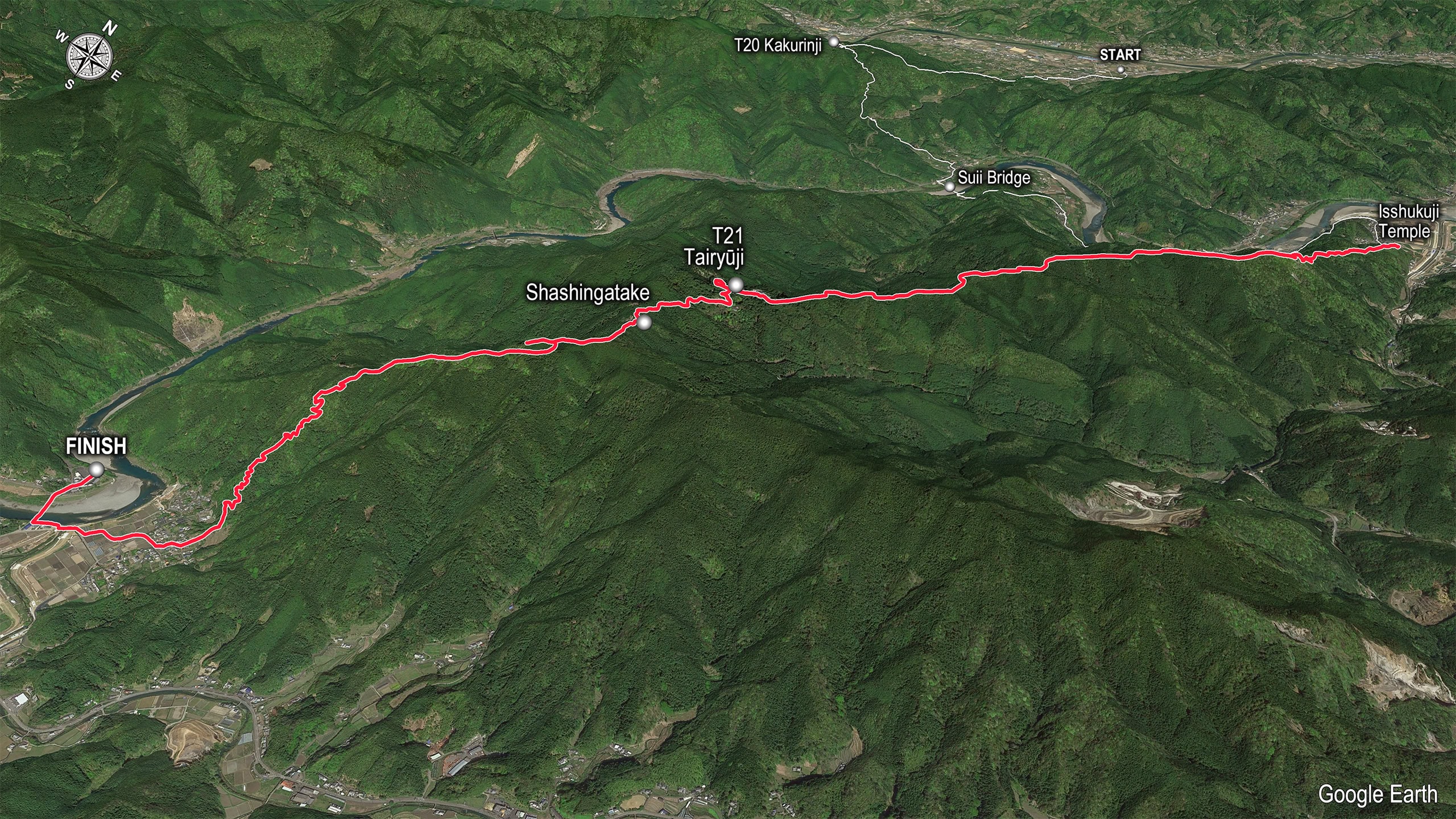
the Kamo-michi trail
The Kamo-Michi trail starts right by the temple gate of Isshukuji 一宿寺, so don’t go inside the temple.
You see some broken old stone distance posts collected from the mountain there.


The entire 4.5km of Kamomichi (with the Iwaya-Michi route, a total of 10km) is unpaved and natural, conserved in the old condition as much as possible without damaging its historical value.


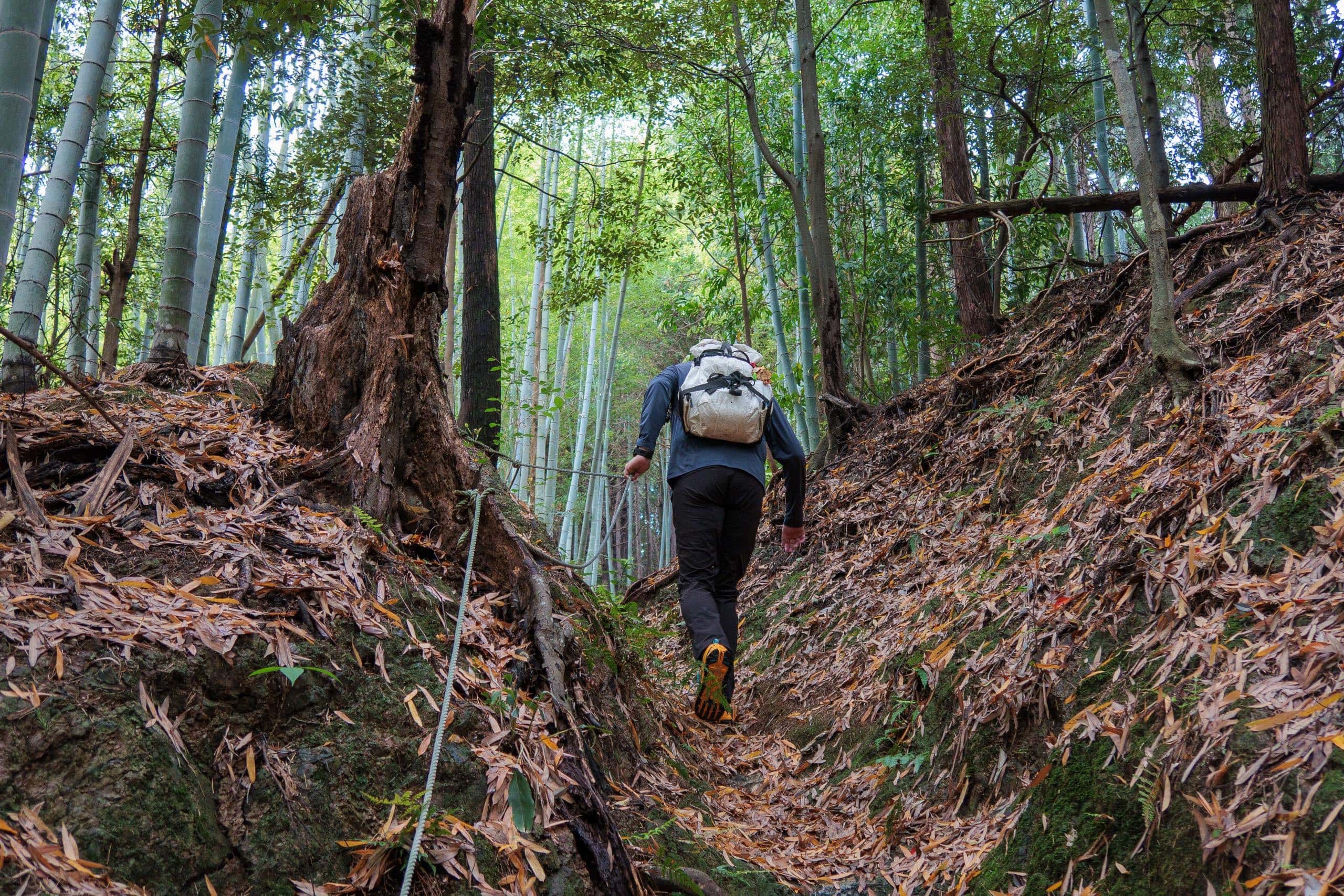
After the first short but steep part, a long stretch of ascends through bamboo forests follows.

The trail then turns steeper and rougher, switchbacking through general mountain tree forests.
About one kilometer from the trailhead, all the mountain surfaces are suddenly covered with white stones and big rocks.

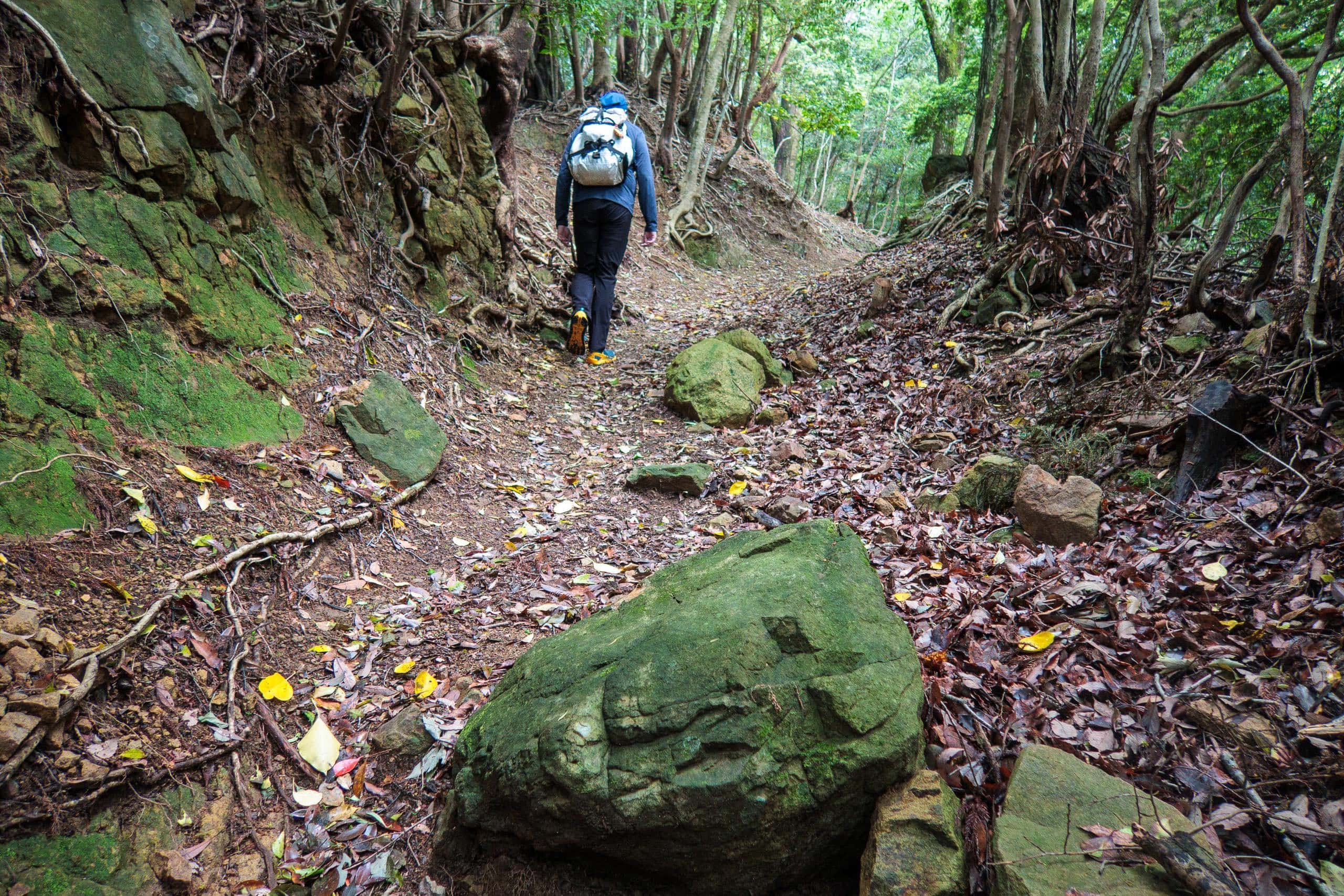



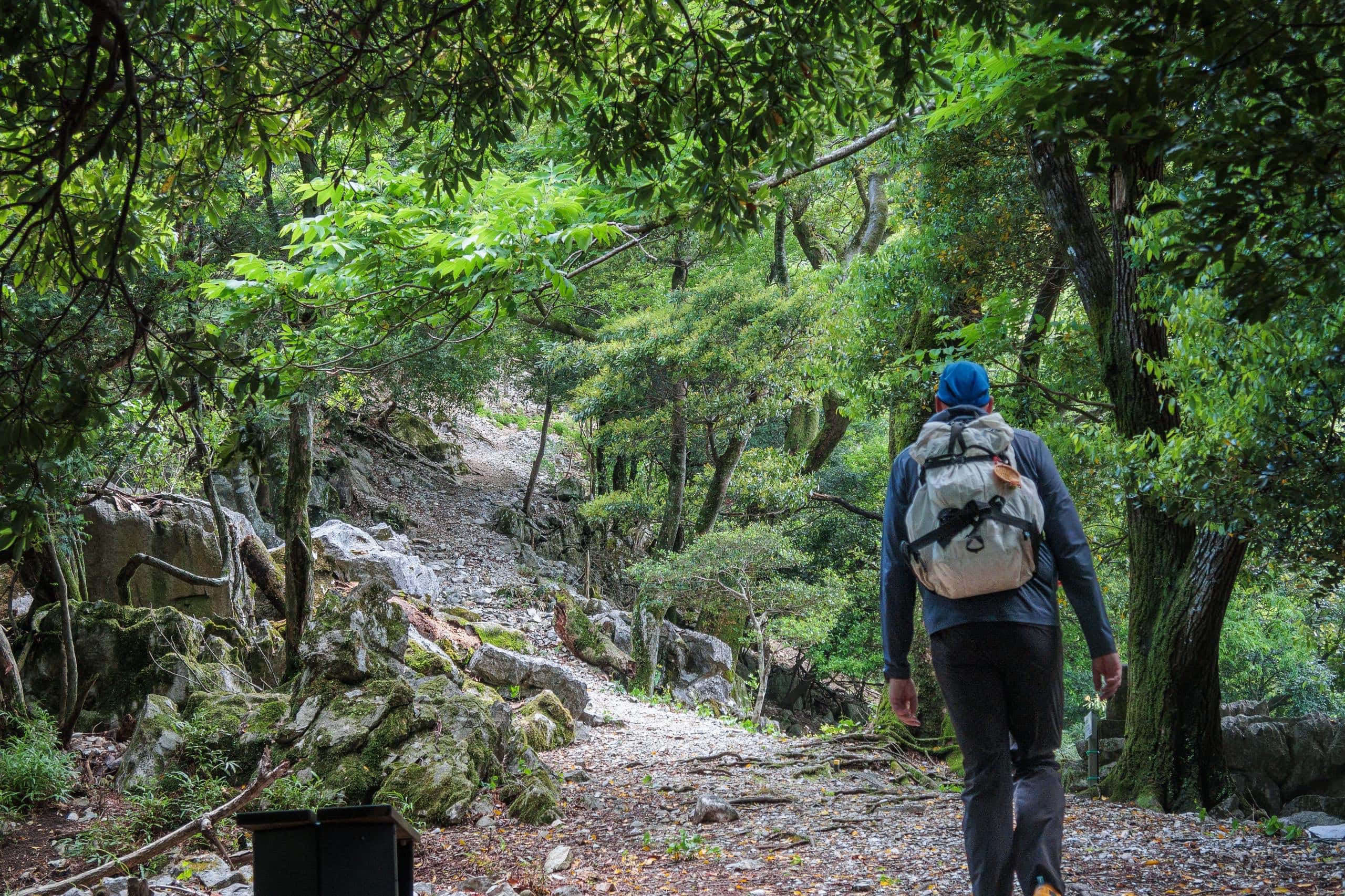
The mountains around T21 are formed with massive limestones and marble rocks. Old mines of those minerals can be seen along the pilgrim trails, and this white area on the Kamo-michi trail is one of them.
You can see T20 and the valley villages below the temple from a viewpoint here.





The Folklores on the Kamo-michi trail
There are a couple of sites that have fascinating legends in this part of the trail. For example:
An old stone monument marking the point from where Kobo-Daishi flew to T20…
Obviously, he could fly and must have been way more impatient than the pilgrims in the 17th century who sought a shortcut.


A giant marble rock called the Kobushi-ishi (Rock of the Fist): When this rock rolled down on a mountainside to crash, Kobo Daishi punched only with his left fist and stopped it from falling.
The shape of Kobo Daishi’s left fist still remains on the rock.

Lastly, another big mountain-shaped rock by the trail is crawling (note that it is present progressive) to try to reach T21 from the Isshukuji temple!
It is said that when it finally arrives at T21, this world will sink under sludges…
To our relief, the rock moves “as long as a rice grain” a year. That makes it take over 300,000 years to reach the present location from Isshukuji temple and at least 3.5 times more to go.


After walking up a short but steep and slippery path through the white rocks, the trail leveled off and continued without significant up-downs for the rest of 3.5 km until the point connecting the most commonly used Tairyuji-Michi route.



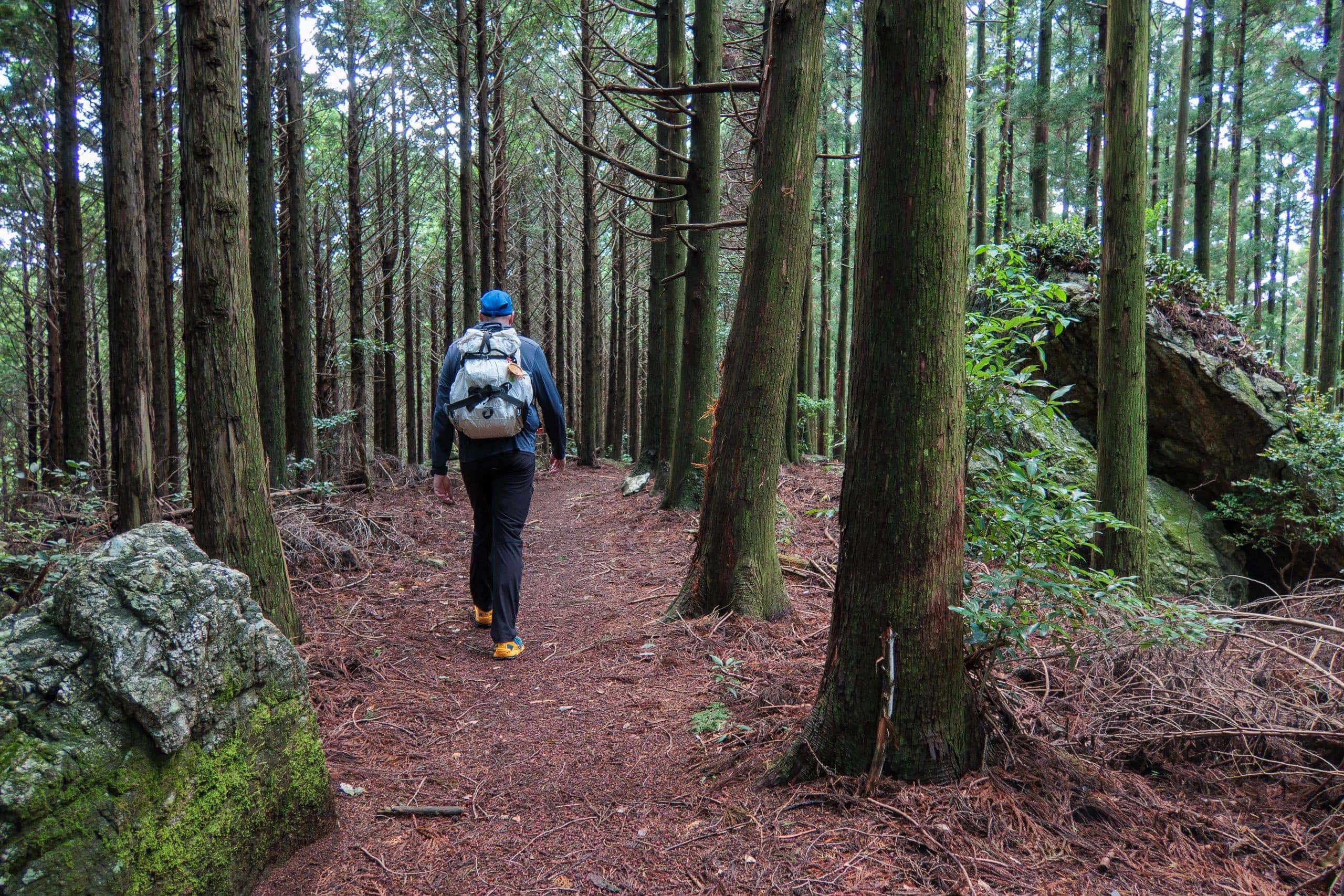



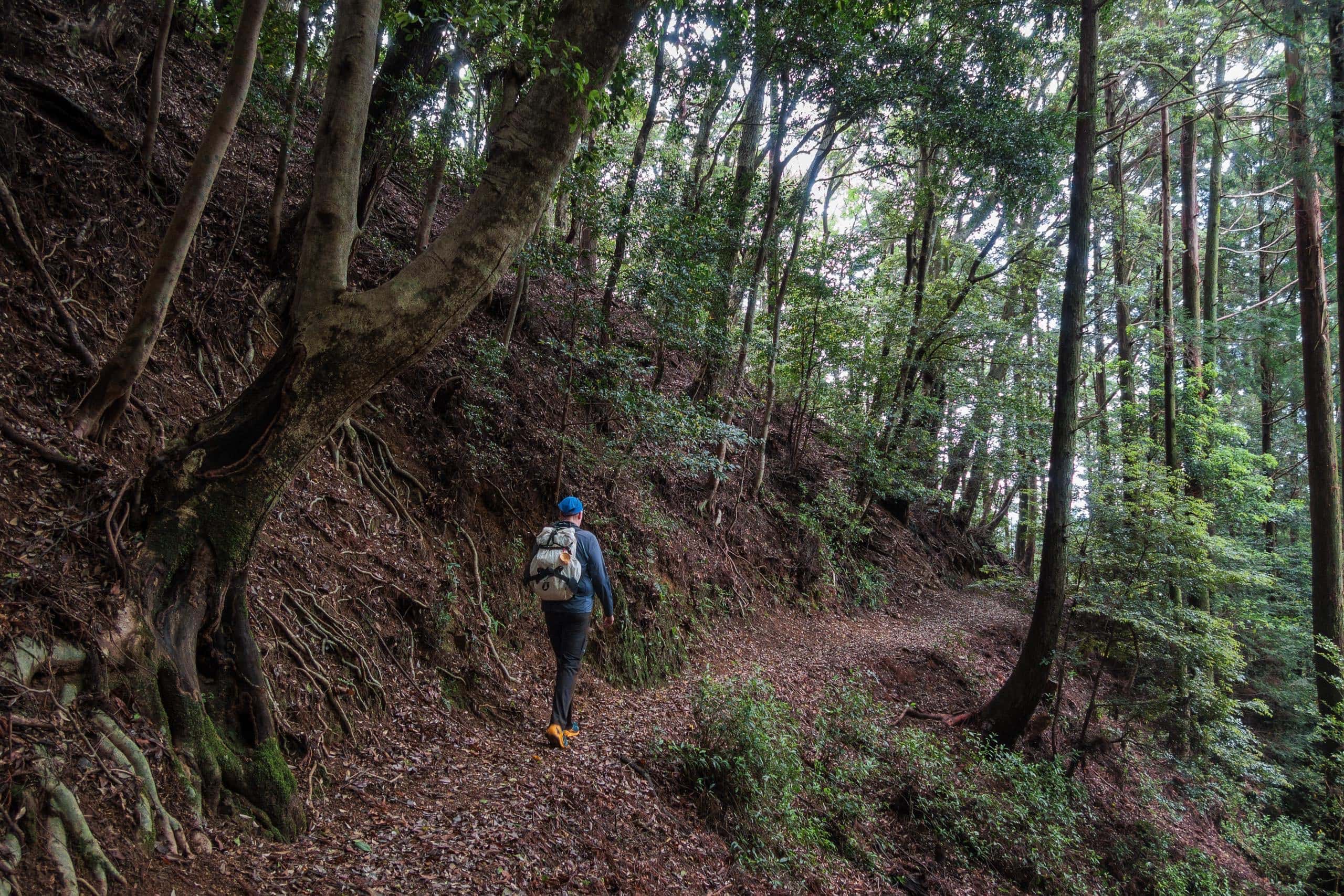

Another route also meets the Kamo-michi and Tairyuji-michi routes at the connection point; a concrete paved forest road.
This paved road is the only way for car and motorbike pilgrims to ascend the mountain unless they want to use the ropeway. The car parking lot for temple visitors is located about a hundred meters lower from the connection point, so car pilgrims must walk the last kilometer of steep and winding road. The parking fee is 500 yen a car and is paid at the stamp office.
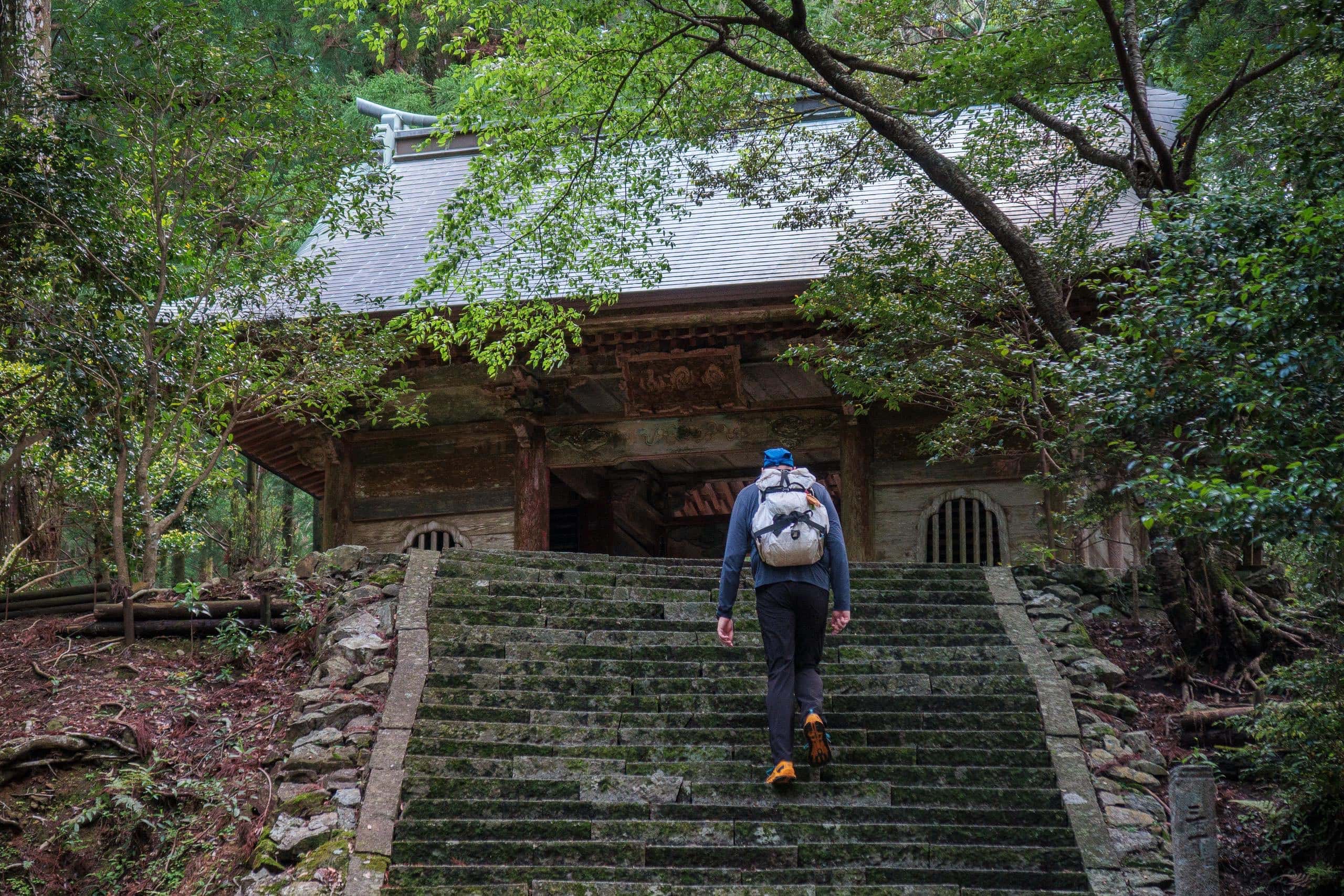
Motorcyclist pilgrims can pass the car parking lot, drive further up to the temple’s main gate, and park their motorbikes at a small space behind the gate.
Occasionally, you may see a small truck or a car driving up to the temple buildings but don’t frown; they are either temple monks, staff, or contractors with special permission.


How about bikers? Yes, bikes can come up to the temple via the paved forest road and ropeway, but of course, you must get off your bike and push inside the temple area. Park your bikes by the bathroom near the stamp office or ropeway station. I believe many bikers go to the ropeway bottom station, which is the Michino-eki Washinosato 道の駅鷲の里. They leave their bikes there and take the ropeway for a round trip because the paved forest road is very narrow, steep, and winding. Besides, there are no guardrails even if the outsides of the road are mostly cliffs. Not a fun and safe condition for cycling down.


At the stamp office, we found a very familiar face, the assistant priest-monk, who was always nice to us and I learned so many stories and histories about the temple from him.
I bought some stickers of the temple’s main deity, Kakuzo-Bosatsu 虚空蔵菩薩 for my iPhone and charms.

Since he knew we were leaving Japan to travel overseas for a while after this pilgrimage, he kindly made a special prayer, quietly mumbling some mantras in his mouth to send a strong power into the charms to wish they protect us well.
Though T21 is a large temple with a long, rich history, it is today managed only by the chief monk’s family and a couple of long-time staff members. I know all of them and have many good memories here.
I will miss this beautiful temple so much.

Can’t-miss features at T21
I could write another extended essay about the temple, but I write only a few features that most pilgrims, especially international ones, easily miss here.
The drawing of a dragon on a corridor ceiling

This dragon drawing can be found above the long corridor inside the multiple glass slide windows in the same big temple hall with the stamp office. Usually, the center part of the windows is kept slightly open around an offertory box for visitors to stick their heads inside to look up to see the drawing.
The dragon design is also used for T21’s original ‘tenugui’ (Japanese traditional thin cotton towels) sold at the stamp office, which is my favorite item to carry around for hiking and as nice lightweight souvenirs.
Why a dragon? The temple’s name, Tairyuji, literally means ‘temple of a big dragon.’
Marble stone steps


As mentioned before, the mountains of T21 are gigantic rocks of limestones. Some of the high-quality marble stones produced here were used to build the National Diet of Japan.
In addition, the old stone steps between the stamp office and the central temple area and between the Daishi-do hall and the pagoda were built with all marble stones.


Daishi-do hall

“The Western Koya” is a nickname of T21.
Koya here means the Koyasan (Mount Koya), the religious center of the Shingon Buddhism sect Kobo-Daishi himself founded and a UNESCO world heritage site in Wakayama. It is also where Kobo-Daishi has been in eternal prayer and meditation since A.C. 835 inside an underground room of the most sacred area of Koyasan called Okunoin. Believe it or not, he is supposed to be still alive there; that is why a couple of selected monks bring meals twice a day to serve him every day…
Okunoin is also one of the most popular places in the Koyasan area for tourists, mainly because of the famous enormous old cemetery in ancient cider trees in front of the Okunoin.


The sacred area of the Okunoin is separated from the cemetery by a small river. A stone bridge is the only way for visitors and worshippers to cross the river, and all must take off their headwear, and no photographs/video can be taken in the area over the river. Though there is a big temple hall in the sacred site, the truly special place, the room of Kobo-Daishi, is behind it, under a small hut-like temple hidden behind walls.
At T21, unlike most of the other 87 temples of the Shikoku Pilgrimage, its main hall and Daishi-do hall don’t stand close to each other. There was a small stone bridge on the path to the Daishi-do for the pilgrims to cross, just like Koyasan’s Okunoin. The Daishi-do hall is a beautiful and solemn architecture decorated with carved pillars and walls.


Again, like the Kobo-Daishi’s room behind the Okunoin temple in Koyasan, pilgrims are encouraged to go up on the outside corridor of the Daishi-do hall and proceed to the back. There, you see another small hut-size exquisite temple protected by silent mountain cliffs. The statue of Kobo-Daishi is hidden inside this small temple, so if you are willing to do pilgrim rituals or prayers, it is more appropriate to do it here.

Inspired by this similarity of landscape design around Daishi-do to Okunoin’s in Koyasan, people started calling T21 the western Koya.
Good news. While it is forbidden and impossible for anyone even to get a glimpse of meditating Kobo-Daishi in Koyasan for apparent reasons, T21 opens the door of the small hut temple behind the Daishi-do temple only once a year for visitors to see the statue of Kobo-Daishi inside. The date moves around every year because T21 follows the lunar calendar to set the special day, the date Kobo-Daishi went into his eternal meditation about 1190 years ago…
Gumonji-do hall

The reason why young Kobo-Daishi (Kukai was his monk name) came to this temple was to try a particular Buddhism practice called Gumonjiho 求聞持法 to seek a way to attain enlightenment.
According to a temple legend, He conducted the practice on the cliff south of the temple, where a big bronze statue of him is sitting. Allegedly, he didn’t reach that state here because he did the practice again inside the cave near T24, which resulted in success.
Since then, for over 1200 years, T21 has remained one of the few temples in Japan that conserve the secret teaching to do the Gumonjiho practice properly. Even today, a few monks and nuns come here every year to receive the secret teachings and conduct the practice.
General people like us can get the most simplified idea of what they do during the Gumomjiho practice like this; chanting the mantra of Kokuzo Bosatsu 虚空蔵菩薩, the main deity of T21, one million times. But, of course, it is not that simple. According to what I heard from monks, the practitioners of Gumonjiho do way more rituals than that. They do this physically and mentally arduous practice while staying in a small hut near the main hall for 50 days. Walls and mountain slopes protect the hut to isolate the practitioner from the outside world, and interrupting them is strictly prohibited. In any way, general temple visitors by no means would see the practitioners outside the hut during the daytime.
Seeing a sand yellow color monk robe hanging dry outside the hut today, we figured another practitioner was in there, conducting the same secrets young Kukai did.



To Shashingatake, the sacred cliff of T21 Okunoin

Looking back one more time to say goodbye in my heart to my dear temple, we walked down the long stone stairs in front of the main hall to the ropeway station for the last vending machine and bathroom.



It was already 3:30 pm when we finally left the ropeway station to proceed to the Shashingatake cliff. I was so thankful it was the most extended daylight season of the year and super sunny weather today. If this was wintertime, we needed to come out of the mountains by 4 pm to not walk in the dark.
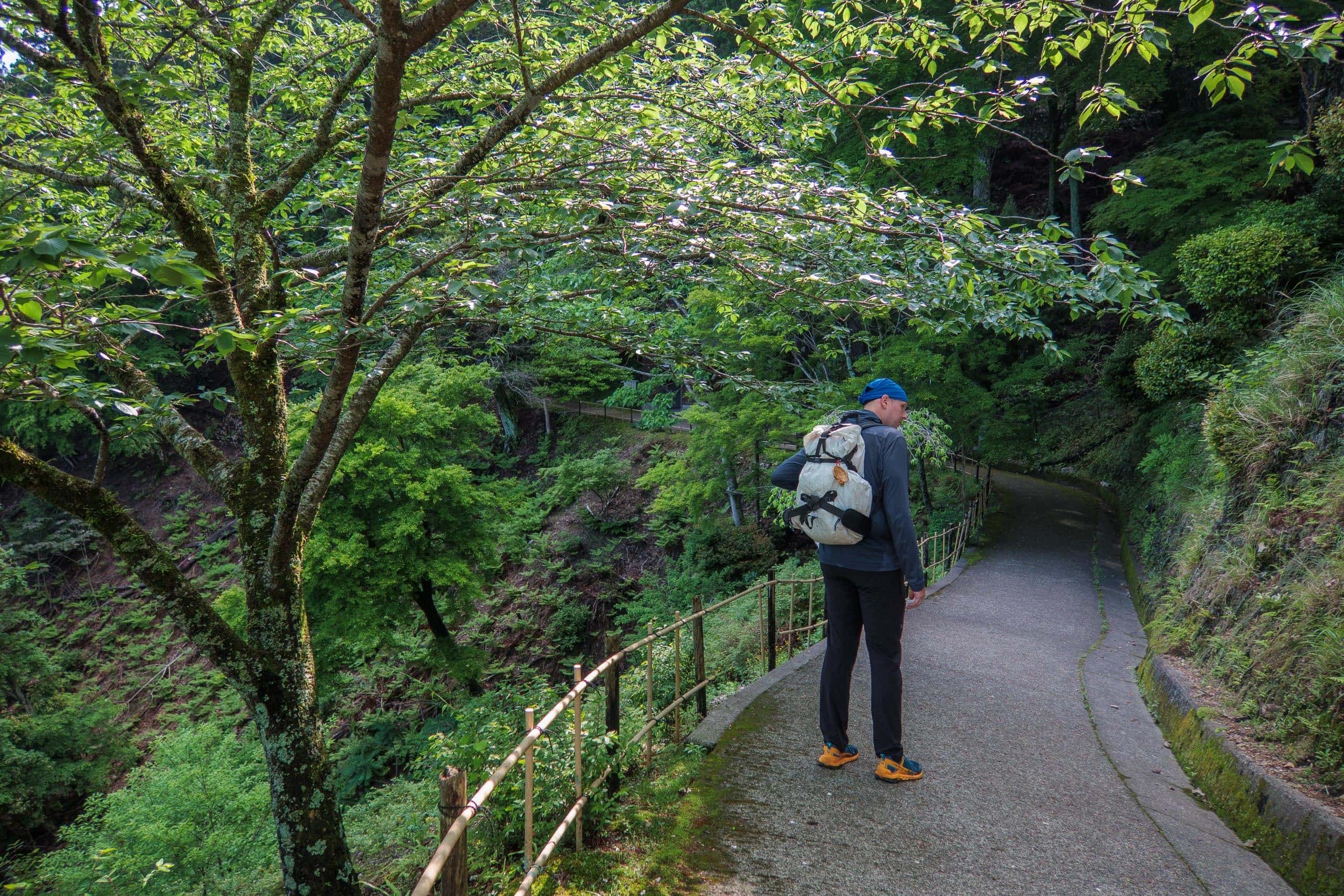





Yamasakimori


On the top of the peak behind the back of the Kobo Daishi statue on the Shashingatake Cliff, there is another rather weird-shaped sculpture facing the far west sky beyond layers of mountains.
Needless to say, this is one of the great viewpoints that Tairyuji Mountain offers. Often, you can see small ropeway cars passing each other above a cedar-tree-covered deep valley from there. So, what is this bronze statue?
It is called Yamasakimori, one of the “sakimori” series of bronze statues by a world-acclaimed Japanese great sculptor, Masayuki Nagare 流政之. He was from Takamatsu, Kagawa and passed away in 20218 at age 95.
“The bronze statue version of a guardian of Nature whose original mold was made from a sacred giant Japanese cedar tree from the T21 forests. “This is a human-shaped work with a hollow in its center… the hollow is holding lives or dreams,” said Nagare. The statue is his powerful expression of the desire for peace…”
Tairyuji Ropeway webusite

We passed the Shashingatake cliff without going to see the Kobo-Daishi statue, as we were coming back here again tomorrow morning to walk down the Iwayamichi route.
At the fork, where pilgrims usually take the left trail to go down on the Iwayamichi route, we went on to the right path for the Kitajimichi route.



Kitaji-Michi Trail
The distance-wise, Kitaji-michi is not especially long; less than 3km. All we were going to do was just walk down it to the bottom of the mountain and another 1.5km walk to tonight’s lodge, Sowaka. Sounds easy, right? If this were a regular well-maintained trail, I would comfortably calculate that 1.5 hours should be enough.
But I knew the reality on this trail. It is pretty rough and unmaintained.
Neither the Japanese guidebook nor the English guidebook for Shikoku Pilgrims for walking has the Kitaji-Michi route because few pilgrims or even hikers use it anymore. Kitaji-Michi runs mostly along the ropeway line and exits at the opposite side of the mountain from the regular direction to T22.

I heard it was still the main route for the villagers living on that side of the mountain to visit T21 for a while after pilgrims didn’t see the point of taking this way to the next temple. And the ropeway came to provide a much faster, easier, and more weather-proof option to the villagers. When no one walks on a trail, no one cares to maintain it regularly. Those forgotten trails are eventually covered with plants, returning to a part of the mountain forests.
I had walked on the Kitajimichi 6 years ago, which was already pretty rough and unclear. Since then, I never walked on it again, but I was sure heavy rains and typhoons continuously damaged the trail more every year. It would not be an easy and quick walk down.
We were taking this route simply for fun and, luckily, had time for it. Aside from me having walked on it before, we also had a GPS track of the Kitaji-Michi route. The trail is not marked with our familiar red letters on white metal plate signs to indicate the Shikoku Pilgrimage trails.
We don’t recommend that anyone take this route unless they are experienced hikers on rough terrain, have a GPS to navigate, and have more than a couple of hours. Walking down this trail is not worth your time if you just want to take a route that others rarely walk.

Shortly after we started walking down the Kitajimichi, we made a slight detour roundtrip to the statues of a group of wolves on a cliff. The ropeway guide always points at and introduces them to passengers as there used to be a lot of Japanese wolves living on this mountain. Japanese wolves went extinct more than 100 years ago, in the early 20th century, by the way.



We returned to the Kitajimichi trail from the cliff of wolves, trying to speed up our walking pace even more. Thankfully, the decline had been gradual, and the trail surface had been wide enough for the two of us to comfortably speed-walk. We passed another former limestone mining area, where old powerline poles still stood along the trail. But I knew our peaceful walk time was ending soon.

After the limestone area, the trail suddenly went down sharply and turned into a narrow trace through native tree forests. The rest of the trail condition down to the bottom was getting worse and steeper. Aside from being under thick trees, we were now on the shadow side of a mountain ridge. Dimmer lights that managed to come through the thick leaves and no phone signal irrationally made me nervous, even if I knew the route.

But I also knew there would be some exposed spots along the way ahead of us where we should have been able to catch phone signals.
At the first of them, a small viewpoint, my phone signal was back, and I called Sowaka. When booking a room, I told them our check-in time was 5 pm. It was already 20 minutes to 5 pm, and we were still at least 2.5km away and 400m up from Sowaka.


On a flat paved road, a 2.5km walk should take less than 30 minutes for us. But a very rough, unmaintained steep downhill was expected to continue; we had to stay focused and walk down carefully and slowly.
I told Sowaka where we were right now, that we didn’t get lost and knew how to get there, and that we should be able to check in by 6 pm.

When you are late to your planned check-in time…
When you expect to be late to your planned check-in time to an accommodation along the Shikoku Pilgrimage trails, especially for those smaller-sized family-owned ones, you should make your maximum efforts to find a way; the easiest is by phone, to communicate with them to let them know you are behind the time.
Aside from the internationally well-known Japanese punctuality, the owners of your lodges would start worrying if you may get lost, especially when you are supposed to come through the mountain trails. It is not a rare case that some owners or staff would drive their car to look for you or wait for you at a trailhead where you are supposed to come out.
So, letting them know you are not lost and surely coming to stay at their place makes them spend time worrying about you and instead use the time to run their inn during the busiest time of the day.
I have heard from some international pilgrims/hikers said they thought it was no problem to walk late evening through the dark and get to their accommodations at 8 or 9 p.m. No. Just, NO.
Pilgrims’ morning is early. Many of them want to start walking around seven or even earlier. That means the owner of small inns has to wake up much earlier than that to cook breakfast for them after they served dinner, clean up the kitchen, dining room, and bathroom, then rush to bed to wake up early the following day. A guest arriving at 9 pm causes them to stay up and wait, pushing all the cleaning up and preparation time for the next day back to less rest time.
The lower part of the Kitaji-michi trail – very steep and rough
Soon we found that our estimate of a longer time to go down than it looked on the map was correct.
As is often the case, the lower near the mountain-foot part of trails got even rougher. Without the GPS track, we would have had difficulty finding the route, as some parts were damaged or washed away by runoff water after storms and minor landslides.
Fallen leaves from the last fall still covered thickly on the steep mountainside and trail, so we had to be careful and slow not to slip and slide down.



The bottom part of the mountain was man-planned cedar tree forests that blocked sunlight, so we patiently kept walking through the clammy dusk, stumbling on piles of big cedar tree branches every 30 seconds.

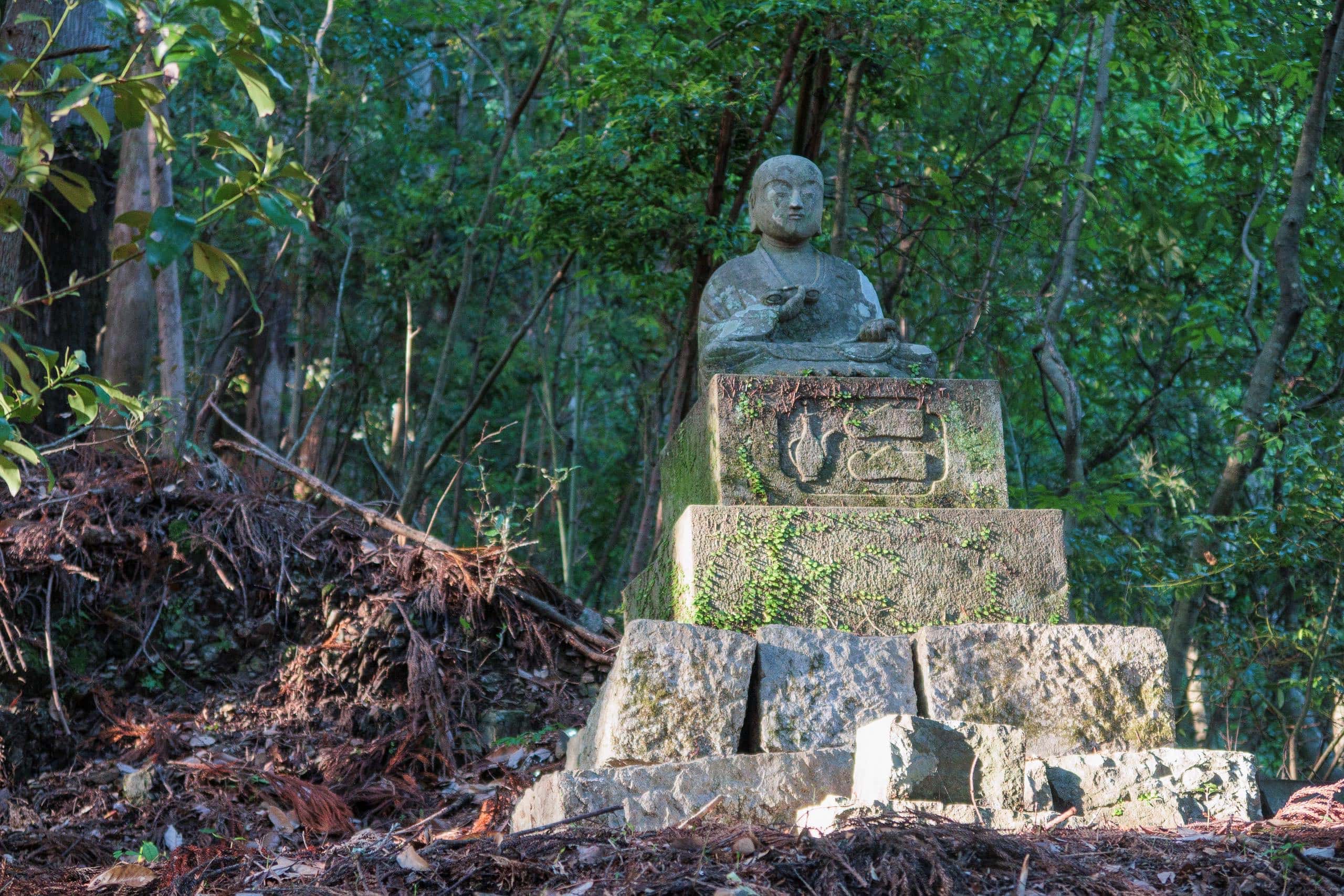

Coming out of the forest finally, I was surprised at how bright outside still was. The sky was still blue, like mid-day. We walked through a couple of houses to exit from the mountain area to Kitaji hamlet.



We saw the ropeway station by the curving Nakagawa River beyond sun-reflecting rice paddies. Even if Sowaka was right there, located just behind the ropeway station, we had to go all the way around to cross the red bridge over the wide river. Now, on flat ground, we felt much more relaxed and enjoyed the beautiful colors of the river and farm village scenery as we were striding the last 1.5km.

At 5:57 pm, We barely made it to Sowaka by 6.
As checking in, we saw other guests already having dinner in the dining room.
Sowaka has always been my favorite place, and they didn’t disappoint us at all this time. Our room seemed renovated recently, the tatami floormats still smelled new, and the walls looked newly painted. Since we needed to have dinner before their dining hall closed, we hurried to collect our dirty clothes, put them in a laundry machine, and come to dinner first.



The dinner Sowaka served was very home-cooked style dishes like general Japanese people would eat for their daily dinner at home. We liked it that way rather than having a feast with tempura and sushi every night. As a breakfast option, when I made a booking, we could choose to eat at Sowaka or get Onigiri (rice balls) to take for those who want to leave earlier than breakfast time.
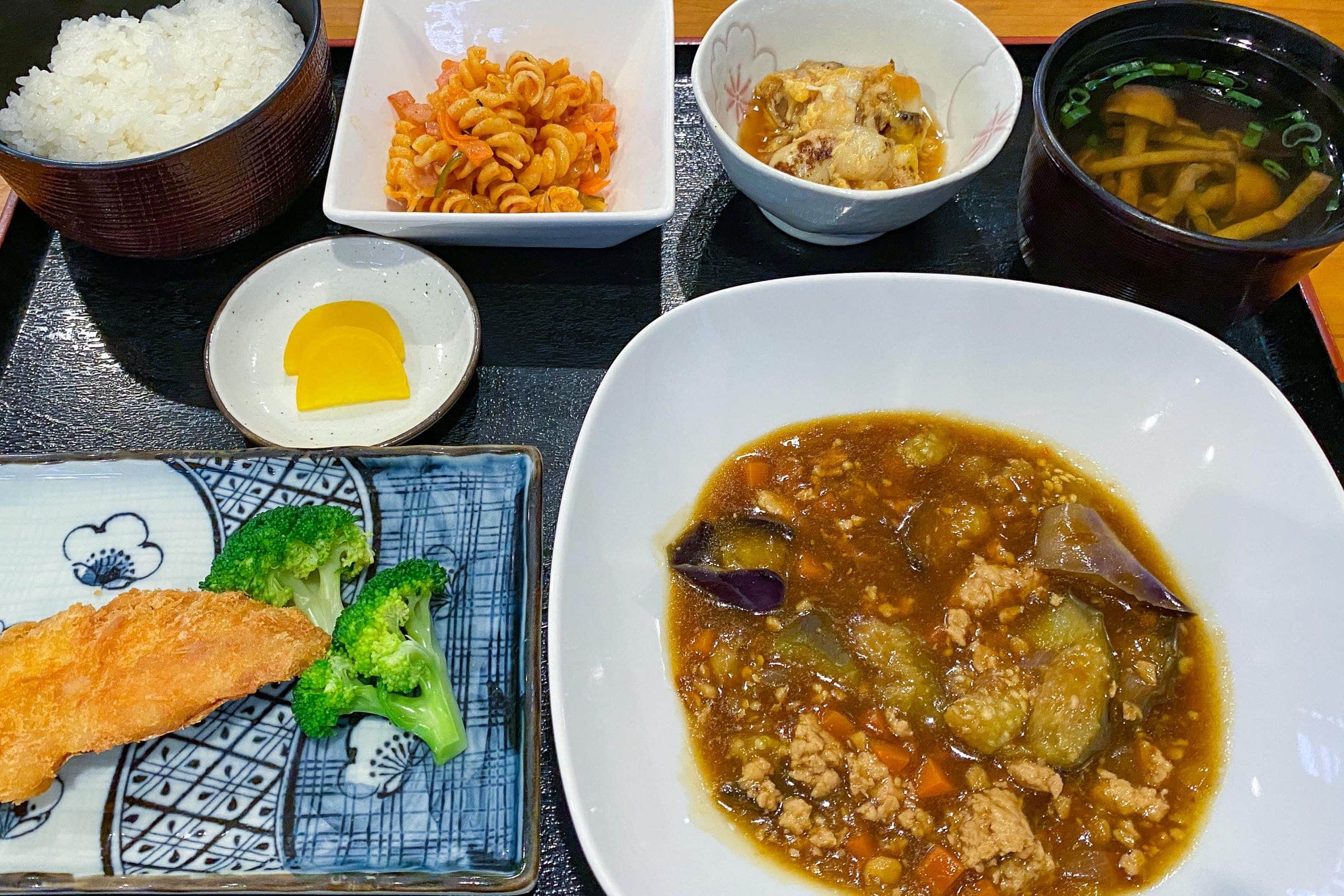

Since we knew the next day would be another long day, we got packed onigiri for breakfast from them in advance while we were eating dinner. Erik is usually not a big fan of rice, so he was going to eat his nutrition bars tomorrow, and a total of four onigiris would be my breakfast and lunch. Perfect plan.
We ended the long and hard day by jumping into Sowaka’s fabulous big public bath. Apparently, no female guests other than me tonight, so the soaking in hot relaxing water and big washing space was all mine. What a treat and the perfect way to regain the energy tomorrow.
In 2024, the long-awaited return of our lifesaver!
In 2024 summer, with a new owner and staff, Iyashi-tei KOKŪ いやし亭・心空 soft-opened at the same location and officially started fully operating the following fall.


The major parts of the building were renovated.
- The 1st-floor rooms are smaller (including three rooms with a western-style bed) for solo or a couple of guests.
- The 2nd-floor rooms are bigger.






Note:
- The room rate is per person.
- The rate difference between booking by phone and via is due to the processing fees.
- The room rate is subject to change.
Book via phone: 0884-63-032
Online booking via major Japanese and international booking websites
Lunchtime restaurant will be available later in July. (Ask them about business hours)
A seasoned former hotel chef will be cooking at KOKŪ.
Dietary requests are negotiable, and you MUST ask them in advance.




Shikoku Pilgrimage – Day 20
| Start | Michi-no-eki Hinanosato |
| Distance | 20.4km |
| Elevation Gain/Loss | 1414m/1391m |
| Finish | SOWAKA |
| Time | 10h 18m |
| Highest/Lowest Altitude | 549m/25m |
| Visited Temples/POI | T20, T21 |
Route Data
The Shikoku Pilgrimage 2022 – Vol.1: late April to mid – June 2022







Comments